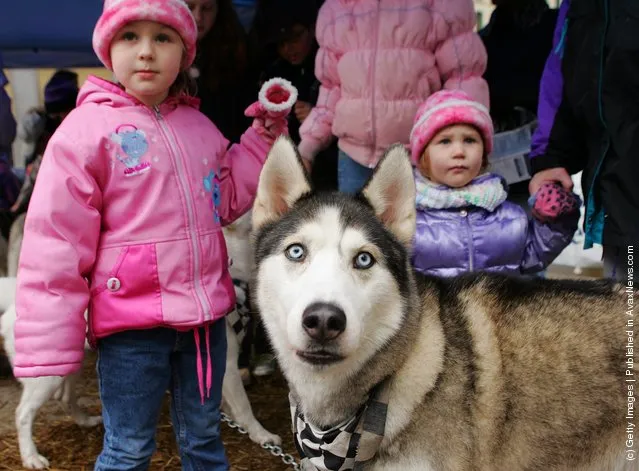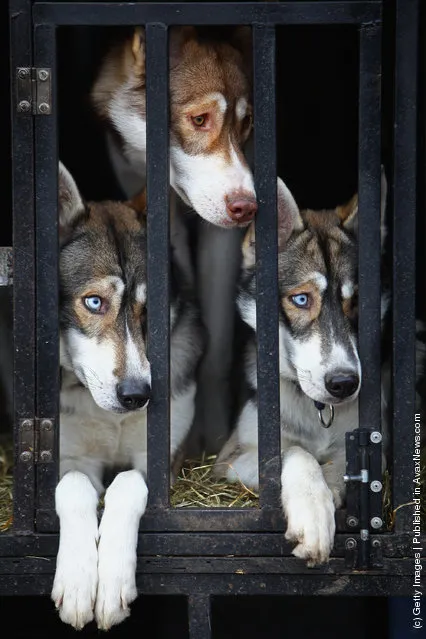“Husky is a general term for several breeds of dogs used as sled dogs. Huskies were originally used as sled dogs in northern regions but are now also kept as pets. The word “husky” is a corruption of the derogative term “Eskie”, also given to the Esquimaux tribes that came into contact with Europeans who made early expeditions into their lands. The most common huskies are the Siberian Husky and the Alaskan Husky.
Huskies should not be confused with other sled dog breeds such as the Alaskan Malamute and the Canadian Eskimo Dog (Canadian Inuit Dog). As although these breeds were originally bred to pull sleds, the respective manners in which they pull are very different. The Malamute, for example, is generally slower in long-distance dogsled racing against smaller and faster breeds such as the husky.
Huskies are known for commonly having different colored eyes, known as heterochromia. The most common eye colors they have are brown and light blue. Huskies have thick fur to protect them from the harsh, cold weather, but it protects them against heat as well, although they like cold weather most.
Huskies are good family pets, but must have a patient and devoted owner who will spend lots of time training and playing games with them. Huskies are known to enjoy digging, and if not on a leash or in a fenced area they are known to run away. Husky owners must make time for training and exercising. These dogs may present difficulties for first time dog owners or people who are not assertive. Because they are pack animals, they will naturally adopt the role of leader (the alpha dog) unless the owner assumes that role instead”. – Wikipedia
Huskies should not be confused with other sled dog breeds such as the Alaskan Malamute and the Canadian Eskimo Dog (Canadian Inuit Dog). As although these breeds were originally bred to pull sleds, the respective manners in which they pull are very different. The Malamute, for example, is generally slower in long-distance dogsled racing against smaller and faster breeds such as the husky.
Huskies are known for commonly having different colored eyes, known as heterochromia. The most common eye colors they have are brown and light blue. Huskies have thick fur to protect them from the harsh, cold weather, but it protects them against heat as well, although they like cold weather most.
Huskies are good family pets, but must have a patient and devoted owner who will spend lots of time training and playing games with them. Huskies are known to enjoy digging, and if not on a leash or in a fenced area they are known to run away. Husky owners must make time for training and exercising. These dogs may present difficulties for first time dog owners or people who are not assertive. Because they are pack animals, they will naturally adopt the role of leader (the alpha dog) unless the owner assumes that role instead”. – Wikipedia

American explorer Robert Edwin Peary (1856–1920) at his base on return from the North Pole with his huskies. (Photo by Hulton Archive/Getty Images). 1909

A member of Amundsen's Antarctic expedition, believed to be his assistant Hansen, with a sledge and team of huskies beside the Norwegian flag at the South Pole. (Photo by General Photographic Agency/Getty Images). December 1911

A young girl sits on snow with a Husky dog resting on her lap at the kennels of Tat Duval in East Jaffrey, New Hampshire. (Photo by Douglas Grundy/Three Lions/Getty Images). Circa 1950

A Husky dog pulls a young girl and her soft toy on a dog sledge. (Photo by Douglas Grundy/Three Lions/Getty Images). Circa 1950

A Husky dog pack leader with the remains of a bone between its paws. (Photo by Douglas Grundy/Three Lions/Getty Images). Circa 1950

Two bright-eyed Husky dogs after a refreshing sleep. (Photo by Douglas Grundy/Three Lions/Getty Images). Circa 1950

Pet husky dogs owned by the Webb family of Blue Mountain Lake, New York. (Photo by Orlando /Three Lions/Getty Images). Circa 1955

Pet husky dogs owned by the Webb family of Blue Mountain Lake, New York. (Photo by Orlando /Three Lions/Getty Images). Circa 1955

A Siberian Husky looks on during the 6th International Dog Sled Racing Competition January 7, 2006 in Hasselfelde, Germany. (Photo by Carsten Koall/Getty Images)

The husky “Tau” pulls the the sled of Maria Gretzinger through the forest on January 23, 2006 in Siegsdorf, Germany. (Photo by Andreas Rentz/Getty Images)

Zeus, a Siberian Husky, looks for a treat while waiting for some snow to pull a sled around at the Motown Winter Blast before Super Bowl XL on February 3, 2006 in downtown Detroit, Michigan. (Photo by Brian Bahr/Getty Images)

Jono a Siberian Husky waits to go in the show at the 103rd Crufts dog show on March 9, 2006 in Birmingham, England. (Photo by Christopher Furlong/Getty Images)

An Alaskan Malamute is seen at a pet market on March 19, 2006 in Beijing, China. (Photo by China Photos/Getty Images)

A nurse administers a “Nebulization Treatment” to a Siberian husky, which will make its fur and skin tenderer at a pet hospital on October 29, 2006 in Changchun of Jilin Province, China. (Photo by China Photos/Getty Images)


Pete Jones and his team prepare for the 27th annual Aviemore Husky Sled Dog Rally beside Loch Morlich on January 21, 2010 Aviemore, Scotland. (Photo by Jeff J Mitchell/Getty Images)

Lisa Curtin prepares for the 27th annual Aviemore Husky Sled Dog Rally beside Loch Morlich on January 21, 2010 Aviemore, Scotland. (Photo by Jeff J Mitchell/Getty Images)




Huskies look out from their pen as competitors prepare for the 27th annual Aviemore Husky Sled Dog Rally beside Loch Morlich on January 21, 2010 Aviemore, Scotland. (Photo by Jeff J Mitchell/Getty Images)
21 Jul 2011 14:51:00,
post received
0 comments
